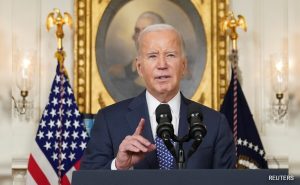2024-05-23 14:26:29
Prince Edward Island (PEI), Canada’s smallest province, announced a 25% reduction in immigration permits, leading to widespread protests from hundreds of Indian students who are now facing deportation. They say the sudden changes by the Canadian province to the immigration policy have left them with an uncertain future. But why has the Canadian province changed its rules to curb the inflow of international students?
Though Prince Edward Island has acted, the problem that is now being associated with international students and lack of infrastructure development is an issue across Canada.
Immigration to Canada, known for its accommodative immigration and citizenship policies, hit a record high in recent years.
Statistics Canada labour force data show the country’s working-age population grew by 411,400 people in the first four months of 2024, a 47% increase over the same period in 2023 and nearly quadruple the average for those four months from 2007 to 2022, reported Yahoo News Canada.
One of the sources of these working-age people is the high volume of international students landing in Canada.
Among the international students, those from India constituted the largest national cohort, comprising 37% of the 579,075 permits issued until November 2023. This figure, however, marked a decrease from the 41% in 2022.
The number of Indians moving to Canada has gone up a lot since 2013. Between 2013 and 2023, the number rose from 32,828 to 139,715, a 326% increase. This increase was fuelled by more Indian students going to Canadian universities.
The number of international students at Canadian universities went up from 62,223 in 2000 to 400,521 in 2021, a 544% increase. International students have been really important for Canadian universities. Since 2000, 45% of the growth in enrolment at Canadian universities is because of international students.
The rise in immigration has put strain on healthcare and housing infrastructure of Prince Edward Island (PEI).
The Premier of PEI revealed a plan to cut the number of international migrants for permanent residency through the Provincial Nominee Programme (PNP). The new policy prioritises essential workers in healthcare, childcare, and construction, while deprioritising those in the food, retail, sales, and service sectors, which the international students mostly engage in.
This change reduces annual permits from about 2,100 to 1,600, a 25% cut, significantly impacting low-skill service jobs.
“PEI offered 1,070 PNP slots in 2018, which doubled to 2,050 slots in 2023 — so this new 25% reduction to 1,600 in 2024 is still 75% higher than it was in 2018. But it’s going in the right direction, and that is the most we can realistically hope for,” stated the Karlstack report.
Jeff Young, director of the PEI Office of Immigration, met with protesters on Friday to hear their concerns.
“We know it’s a difficult situation for a lot of people,” Young said. “But as the premier announced on February 22, the new immigration measures aim to manage our population growth,” reported CBC News.
Young explained that the changes focus on offering a faster track to permanent residency for people with healthcare, childcare, and construction experience. However, service sector employees can still get permits.
“This year, about 215 to 220 permits have been allocated to the sales and service sector,” he said, noting this is a significant decrease from the 700 to 800 permits granted in past years, reported CBC News.
A reduction of approximately 25% in permits, primarily affecting low-skill food service positions. Hundreds of food service workers in PEI will not have their documents renewed, forcing them to either depart voluntarily or face deportation.
INDIAN COMMUNITY PROTESTS AGAINST NEW IMMIGRATION POLICY
The reduction has caused frustration and tension among Indian immigrants who arrived in PEI on temporary work permits. They argue they should be allowed to stay permanently and have participated in protests demanding to be “grandfathered” into the existing PNP system. These protests initially included a threat of a hunger strike, but as of May 22, no hunger strikes have been reported, the report stated.
On May 9, they began protesting and haven’t stopped since. The next big protest is scheduled for May 23 at 175 Richmond Street, Charlottetown — PEI’s capital and biggest city.
Rupinder Pal Singh, a leader of the protests, outlined three main demands.
Firstly, grandfathering current workers into the PNP system. Secondly, fair PNP draws without a point system, which currently excludes many in sales, service, food sectors, and truckers. Lastly, extension of work permits to compensate for lost opportunities due to the government’s changes and economic issues.
RISING IMMIGRATION AND HOUSING CRISIS IN CANADA PROVINCE
According to a report on Karlstack, Prince Edward Island (PEI) has seen a significant influx of international immigrants since 2006.
“Before 2006, international immigration to PEI was virtually nonexistent, but it has recently increased dramatically,” said the report.
Population and household growth continued to outpace the growth in rental vacancies in 2023, keeping rental vacancy rates at historic lows.
The rental vacancy rate on the Island increased marginally between 2022 and 2023, from 0.8% to 1.0%. Charlottetown saw a decline in its vacancy rate, from 0.9% to 0.6%, the fourth consecutive yearly decline.
In Summerside there has been some meaningful improvement in the vacancy rate, going from 1.0% to 2.7%.
Average rents on the Island have increased from $1,020 to $1,079.
Nationally, the rental vacancy rate was 1.5%, down for the second year in a row and down from the 1.9% vacancy rate in 2022. The Island tied Nova Scotia for the lowest vacancy rate amongst provinces, according to Prince Edward Island economic paper 2024.
CANADA PROVINCE PEI HEALTHCARE STRUGGLES
According to the latest data from Statistics Canada, Prince Edward Island ranks last among all the provinces when it comes to the share of the population with access to a regular healthcare provider.
In 2022, 76% of Islanders had a regular healthcare provider, down nine points from three years ago. The national average was 86%, reported CBC News.
Krista Cassell, president of the Medical Society of PEI, said these numbers highlight the need for more family doctors in the province.
“The median wait time, from coming into the ER to being admitted to another hospital unit, is 35.6 hours on PEI. The national average is just 14.7 hours,” reported CTV News.
In 2023, Prince Edward Island had the longest wait times in Canada. It took an average of 41.7 weeks to see a specialist after a general practitioner appointment. Adding a median wait of 23 weeks for treatment after seeing a specialist, the total median wait time from general practitioner referral to treatment was over 64 weeks, according to Statista.
The new immigrants add to the wait-time and residents struggle for healthcare support.
This strain on the small province’s infrastructure is what made the provincial government of Prince Edward Island tighten the tap on the flow of Indian students.
Indian students protest in canada, indian protest in Canada, indian students are protesting in pei, Indian students are protesting in PEI canada, indian students are protesting against pnp canada, pnp canada, pnp rules and regulation, pnp canada immigration, pnp canada requirement, pnp canada eligibilty
Source link
![]()



